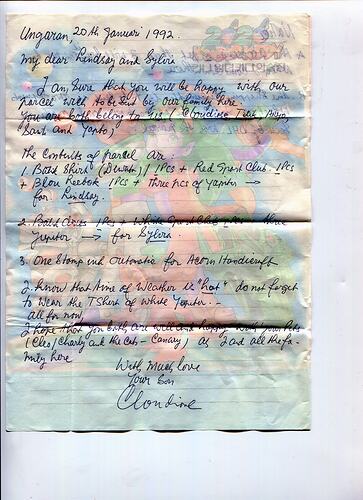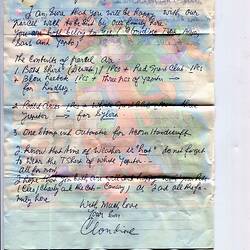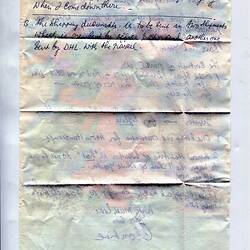Summary
Letter to Lindsay and Sylvia Motherwell, from their friend Cloudiose in Ungaran, Indonesia, dated 20 January 1992. It is written in imperfect English and details the contents of a parcel, including Lindsay's batik shirt, and several other items. The letter was found inside Lindsay's batik shirt, HT56463. Lindsay ran a business importing cane from Asia, and travelled extensively in Indonesia and other South East Asian countries, making friends all around the world.
The letter states that Lindsay and Sylvia 'belong' to their friends in Indonesia - Cloudiose, Titik, Aryo, Santi and Yapto. It also details the contents of a parcel, including one batik shirt, a red sport club, a blue Reebok, and three pieces of Jupiter for Lindsay; a batik dress, a white sport club, three Jupiter for Sylvia; and one stamp ink automatic for Acorn Hanidcraft (?). Cloudiose also sends well wishes to the pets, and says that he will bring pet accessories when he comes to Australia.
Sylvia Boyes (a South African-born orphan) and Lindsay Motherwell (a Melbourne-born drummer) met in Cape Town, South Africa in 1967 through their theatre connections. They fell in love but due to apartheid laws were forced to leave South Africa to marry in London. They subsequently relocated permanently to Melbourne in 1970.
Physical Description
states that Lindsay and Sylvia 'belong' to their friends in Indonesia - Cloudiose, Titik, Aryo, Santi and Yapto. It also details the contents of a parcel, including 1 batik shirt, a red sport club, a blue Reebok, and 3 pieces of Jupiter for Lindsay; a batik dress, a white sport club, 3 Jupiter for Sylvia; and one stamp ink automatic for Acorn Hanidcraft (?). Cloudiose also sends well wishes to the pets, and says that he will bring pet accessories when he comes to Australia.
Significance
Statement of Historical Significance:
This collection provides a significant opportunity to represent political and personal freedom as a motivation for migrating to Australia within the international context of both apartheid in South Africa and the end of the White Australia policy in Australia. The personal narrative is well documented and the objects provide a material way to follow the lives of both Lindsay and Sylvia, both separately and where they coincide in South Africa and onwards together to Melbourne. While this is ultimately a love story, it plays out through the collection against the backdrop of apartheid South Africa, sixties London and an increasingly multicultural Australia.
More Information
-
Collecting Areas
-
Addressed To
Mr Lindsay S. Motherwell, melbourne, Victoria, Australia, 20 Jan 1992
-
Addressed To
Mrs Sylvia Motherwell, Melbourne, Victoria, Australia, 20 Jan 1992
-
Classification
-
Category
-
Discipline
-
Type of item
-
Object Dimensions
182 mm (Width), 248 mm (Height)
-
Keywords
South African Immigration, Travel, Musicians, Jazz Bands, Immigration Policies, Apartheid, Racism, Working Life, International Trade



